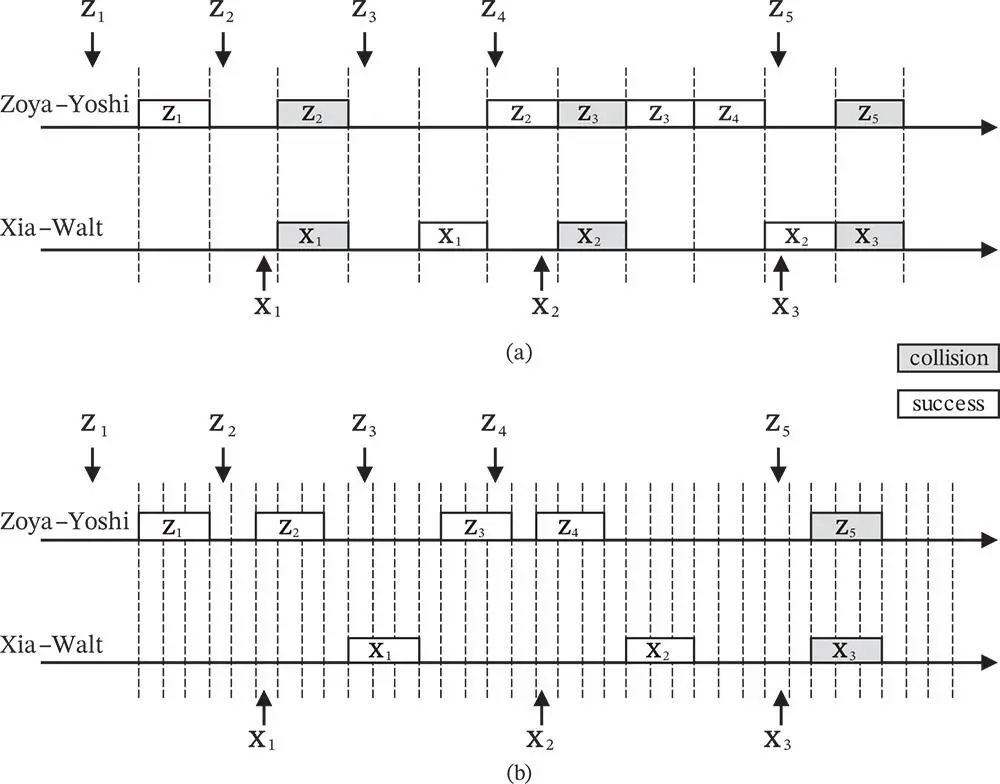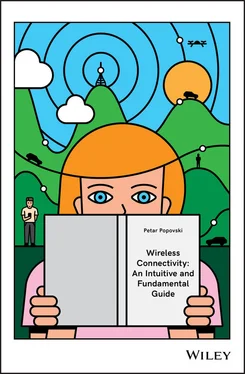We can detect at least two inefficiencies created by the slotted structure:
If a packet arrives after the start of the slot, then the node needs to postpone the first transmission of the packet until the start of the next slot, even if the previous slot is idle.
Consider the collision between and . Although the packets have not arrived at the same time, both Zoya and and Xia need to wait until the start of the next slot. Thus, the slotted structure forces them to be sent at exactly the same time, which leads inevitably to a collision.
 Figure 2.4 Illustration of randomized spectrum sharing between two interfering links, Zoya–Yoshi and Xia–Walt, respectively. Zoya and Xia are transmitters. The pattern of packet arrivals to Zoya (
Figure 2.4 Illustration of randomized spectrum sharing between two interfering links, Zoya–Yoshi and Xia–Walt, respectively. Zoya and Xia are transmitters. The pattern of packet arrivals to Zoya (  ) and Xia (
) and Xia (  ) is identical for both cases. (a) Slotted channel. (b) Carrier sensing solution, with a minislot duration being a third of the slot duration.
) is identical for both cases. (a) Slotted channel. (b) Carrier sensing solution, with a minislot duration being a third of the slot duration.
2.3.2 An Idle Slot is Cheap
The key idea in overcoming these inefficiencies is to shorten the duration of the idle slot and introduce carrier sensing multiple access (CSMA) . Figure 2.4(b)shows an example in which the idle slot duration  is one third of the slot duration
is one third of the slot duration  . Let us use the term minislot to denote the time unit corresponding to an idle slot. After
. Let us use the term minislot to denote the time unit corresponding to an idle slot. After  arrives and Zoya has it available for transmission, she waits until the start of the next minislot and then starts to listen during that minislot. If the minislot is idle, Zoya starts transmission after the minislot ends. The packet
arrives and Zoya has it available for transmission, she waits until the start of the next minislot and then starts to listen during that minislot. If the minislot is idle, Zoya starts transmission after the minislot ends. The packet  arrives at Xia during a minislot in which Xia is not in a transmission state. Since Zoya transmits
arrives at Xia during a minislot in which Xia is not in a transmission state. Since Zoya transmits  during that minislot, Xia detects a carrier and concludes that the medium is busy from a transmission carried out by somebody else. After the transmission of
during that minislot, Xia detects a carrier and concludes that the medium is busy from a transmission carried out by somebody else. After the transmission of  is finished, Xia waits for one idle minislot to verify that the transmission of Zoya has finished. In other words, Xia cannot learn that the transmission of Zoya will finish during the minislot in which it actually finishes and she has to verify the end of Zoya's transmission by detecting the subsequent idle minislot. After that idle minislot, Xia transmits
is finished, Xia waits for one idle minislot to verify that the transmission of Zoya has finished. In other words, Xia cannot learn that the transmission of Zoya will finish during the minislot in which it actually finishes and she has to verify the end of Zoya's transmission by detecting the subsequent idle minislot. After that idle minislot, Xia transmits  .
.
Note that the introduction of a minislot has drastically reduced the number of collisions. This is because the minislot is cheap in terms of time duration, offers a better time resolution, and the system operation can benefit from the asynchronism among the arrivals of the packets across the different devices. However, the minimal resolution is brought to the level of a minislot, such that if two packets arrive at the same minislot, then collision cannot be avoided. This is illustrated by the packets  and
and  . Upon collision, Zoya picks a random number of minislots (not slots!) to wait until the next transmission and Xia does the same. In this way, they create the required asynchronism and likely avoid another collision between the packets of Zoya and Xia.
. Upon collision, Zoya picks a random number of minislots (not slots!) to wait until the next transmission and Xia does the same. In this way, they create the required asynchronism and likely avoid another collision between the packets of Zoya and Xia.
While the idea of minislots and CSMA is introduced here in the context of spectrum sharing, the same mechanism can also be used to design a random access protocol. We can reuse Figure 1.1(b)and think of a system in which Zoya, Yoshi, and Xia use random access to transmit to Basil. Recall that, when we were using the same setting to describe random access, the devices received signals only from the base station Basil and it was not relevant to consider the fact that a device can detect the transmission of another device. By contrast, the new requirement in CSMA is that a device should listen to find out whether the medium has been taken by a transmission from another device.
Figure 2.4(b)presents a rather basic version of CSMA. For example, there can be a variant in which, upon detecting that the medium is not busy, a node waits for a random number of time slots before starting the transmission. The rationale is that, while the medium is busy, there could have been multiple packet arrivals at different transmitters, and if all of them wait only for a single idle slot then a collision occurs. A similar argument is valid for the following feature that is used in practical systems, such as Wi-Fi. Assume that Zoya experienced a collision and decided to wait for 10 minislots. While waiting, Zoya detects that the medium has been busy for 15 minislots. If Zoya counts down the waiting minislots when the medium is busy, then she finishes the countdown while the medium is still busy and transmits after the idle minislot that follows the busy period. Again, the main problem is that many other nodes could have done the same and thus they get synchronized towards a collision. An elegant solution to this is to stop the counter while the medium is busy, thus removing the synchronizing effect that the busy medium may have on the waiting nodes.
We note that, as the minislot becomes the basic time reference of the protocol, then this removes the need to assume that all packets are of the same length. The example in Figure 2.4(b)can be easily reworked by assuming that each of the packets  or
or  has a different length, expressed as an integer number of minislots.
has a different length, expressed as an integer number of minislots.
The gains of carrier sensing improve when the minislot is shorter. Ideally, it should be equal to zero. However, there are practical constraints that put a lower bound on the minislot duration. While it is not part of our collision model, in practice there is always a propagation delay in the wireless signals. This means that, when Zoya starts to transmit  in Figure 2.4(b), Xia does not immediately detect that there is a transmission, and only detects one after a certain time that is required for the wireless signal to travel from Zoya's transmitter to Xia's receiver. The duration of the minislot should be set to be equal to the maximal propagation delay that a carrier signal can experience. In our communication model, depicted in Figure 1.1(a), we work with the (very artificial) assumption that no signal propagates beyond a distance of
in Figure 2.4(b), Xia does not immediately detect that there is a transmission, and only detects one after a certain time that is required for the wireless signal to travel from Zoya's transmitter to Xia's receiver. The duration of the minislot should be set to be equal to the maximal propagation delay that a carrier signal can experience. In our communication model, depicted in Figure 1.1(a), we work with the (very artificial) assumption that no signal propagates beyond a distance of  ; then the minislot duration can be determined as:
; then the minislot duration can be determined as:
Читать дальше

 Figure 2.4 Illustration of randomized spectrum sharing between two interfering links, Zoya–Yoshi and Xia–Walt, respectively. Zoya and Xia are transmitters. The pattern of packet arrivals to Zoya (
Figure 2.4 Illustration of randomized spectrum sharing between two interfering links, Zoya–Yoshi and Xia–Walt, respectively. Zoya and Xia are transmitters. The pattern of packet arrivals to Zoya (  ) and Xia (
) and Xia (  ) is identical for both cases. (a) Slotted channel. (b) Carrier sensing solution, with a minislot duration being a third of the slot duration.
) is identical for both cases. (a) Slotted channel. (b) Carrier sensing solution, with a minislot duration being a third of the slot duration. is one third of the slot duration
is one third of the slot duration  . Let us use the term minislot to denote the time unit corresponding to an idle slot. After
. Let us use the term minislot to denote the time unit corresponding to an idle slot. After  arrives and Zoya has it available for transmission, she waits until the start of the next minislot and then starts to listen during that minislot. If the minislot is idle, Zoya starts transmission after the minislot ends. The packet
arrives and Zoya has it available for transmission, she waits until the start of the next minislot and then starts to listen during that minislot. If the minislot is idle, Zoya starts transmission after the minislot ends. The packet  arrives at Xia during a minislot in which Xia is not in a transmission state. Since Zoya transmits
arrives at Xia during a minislot in which Xia is not in a transmission state. Since Zoya transmits  during that minislot, Xia detects a carrier and concludes that the medium is busy from a transmission carried out by somebody else. After the transmission of
during that minislot, Xia detects a carrier and concludes that the medium is busy from a transmission carried out by somebody else. After the transmission of  is finished, Xia waits for one idle minislot to verify that the transmission of Zoya has finished. In other words, Xia cannot learn that the transmission of Zoya will finish during the minislot in which it actually finishes and she has to verify the end of Zoya's transmission by detecting the subsequent idle minislot. After that idle minislot, Xia transmits
is finished, Xia waits for one idle minislot to verify that the transmission of Zoya has finished. In other words, Xia cannot learn that the transmission of Zoya will finish during the minislot in which it actually finishes and she has to verify the end of Zoya's transmission by detecting the subsequent idle minislot. After that idle minislot, Xia transmits  .
. and
and  . Upon collision, Zoya picks a random number of minislots (not slots!) to wait until the next transmission and Xia does the same. In this way, they create the required asynchronism and likely avoid another collision between the packets of Zoya and Xia.
. Upon collision, Zoya picks a random number of minislots (not slots!) to wait until the next transmission and Xia does the same. In this way, they create the required asynchronism and likely avoid another collision between the packets of Zoya and Xia. or
or  has a different length, expressed as an integer number of minislots.
has a different length, expressed as an integer number of minislots. in Figure 2.4(b), Xia does not immediately detect that there is a transmission, and only detects one after a certain time that is required for the wireless signal to travel from Zoya's transmitter to Xia's receiver. The duration of the minislot should be set to be equal to the maximal propagation delay that a carrier signal can experience. In our communication model, depicted in Figure 1.1(a), we work with the (very artificial) assumption that no signal propagates beyond a distance of
in Figure 2.4(b), Xia does not immediately detect that there is a transmission, and only detects one after a certain time that is required for the wireless signal to travel from Zoya's transmitter to Xia's receiver. The duration of the minislot should be set to be equal to the maximal propagation delay that a carrier signal can experience. In our communication model, depicted in Figure 1.1(a), we work with the (very artificial) assumption that no signal propagates beyond a distance of  ; then the minislot duration can be determined as:
; then the minislot duration can be determined as:










